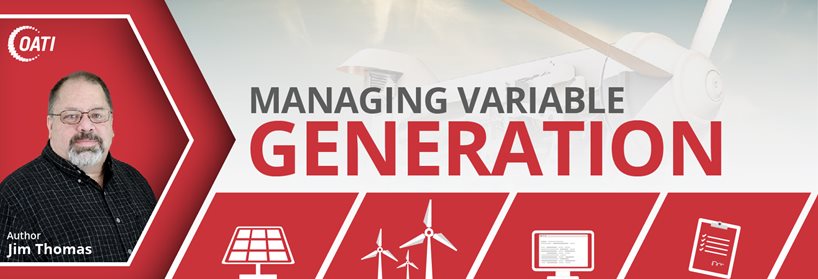Home » Blog » Transmission and Reliability Management » Managing Variable Generation
Managing Variable Generation
Utilities are facing many new changes and challenges in today’s energy industry. Some of these involve the ever-increasing deployment of Variable Energy Resources (VERs) to help meet new standards. These standards require a greater percentage of generation technology, which creates energy while using an environmentally friendly and sustainable fuel source. Expanded wind, solar, and other variable energy generation resources throughout North America have caused utilities and energy markets to change their operational strategies and the way they operate resources to run the power grid.
As a result, these changes have led to many challenges for owners and operators of VER generation. Stricter and more frequent operational updates, more stringent scheduling requirements, a more rigorous review of actual generation output on a real-time basis, and the risk of penalties associated with non-compliance have caused owners and operators of VER generation to reevaluate and revamp their processes as they manage their assets. And how do VER owners and operators meet these requirements? I asked this question to many of OATI’s current customer base and heard a similar response from everyone: automation.
VER owners and operators are seeking to automate as many processes as possible to allow for the most efficient, optimized operation of their asset(s) while meeting and maintaining the requirements set forth by the reliability organizations and markets they deal with every hour. Without automation, the requirements can be too daunting to meet and can be nearly impossible to manage for any real-time operations group. Getting the proper forecast submitted, then tracking, managing, and submitting the forecasted generation output to the market or reliability organization, and finally simply creating and submitting the NAESB e-Tag would keep real-time personnel tied up every hour. When frequent mid-hour changes and sub-hourly scheduling are added, the task quickly becomes unmanageable.
These tracking and scheduling requirements will only increase; reliability organizations are adding more renewable generation every year (estimates predict California will have upwards of 50 percent of their power come from VER generation by 2020). This increased VER generation will likely lead to more reporting and more stringent sub-hourly scheduling requirements, thus putting an even greater strain on the real-time personnel working to optimize these assets.
OATI has worked with companies who own and operate VER generation as they use OATI technology like the OATI Variable Generation solution or OATI webAgent® combined with a Market solution to automate the forecasting process (bringing in the forecast and submitting it to the market or reliability organization as required), the scheduling process (scheduling the output in the company’s system of record, sending the schedule to the market or reliability organization as required, and creating and updating the NAESB e-Tag as required), and the after-the-fact process (updating the schedule to match the actual generation, updating the NAESB e-Tag, and downloading the after-the-fact data from the market or reliability organization for comparison to the shadow settlement capability available in the OATI toolset). This automation helps VER owners and operators optimize their assets while meeting the scheduling, reporting, and tagging requirements of the markets and reliability organizations.
About the Author:
Mr. Jim Thomas is Director of Account Sustainment for OATI. He has over 34 years of experience in the energy industry including power generation, distribution, trading, scheduling, marketing, and sales. Mr. Thomas is also an Account Executive working with current OATI customers to ensure that OATI is meeting their needs in the ever-changing energy industry.
- October 5, 2018
